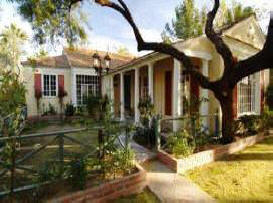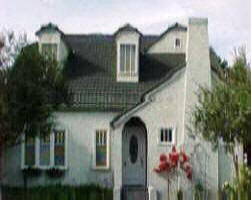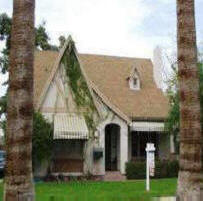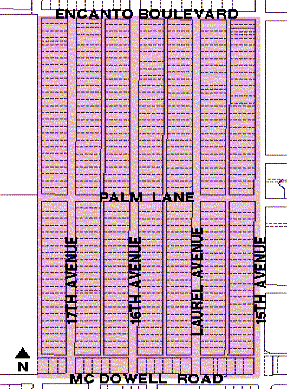|
Windows Into Time
We live in the present. We hope for the future. But
we are inescapably drawn to the past. History is
restored in libraries, displayed in museums, and
recorded in archives and files. We plan trips and
excursions to seek out the past, but fail to observe it
just under our feet. The homes where we live, our
neighborhoods, and the cities that contain them all
stand as silent testament to the past that is our
prologue. On the west-central side of modern- day
Phoenix, a thriving neighborhood serves as an anthology
of the ebb and flow of the 20th century growth, trends,
regulation and economics throughout the city, the state,
and the nation. That neighborhood is
Fairview
Place.
Growing Pains
First settled in 1867, Phoenix grew slowly until after
the turn of the century. By 1911, const ruction was
complete on the Roosevelt Dam, ensuring a stable supply
of water. In 1912, Arizona became a state, and the stage
was set for a boom to begin. Individuals conducted early
Phoenix land development and building companies, usually
subdividing small parcels of land into residential lots.
Speculative construction was rare; homebuilding was
generally done on a contract basis.
Stretching from McDowell Road to Encanto Boulevard and
bounded by 15th and 17th Avenues, Fairview Place
was one of the first attempts at large-scale residential
subdivisions in Phoenix. After recording the plat in
1916, the State Realty and Sales Company ambitiously
promoted the sale of lots.
But the
project was ahead of its time. Outside the city limits,
Fairview Place was poorly served by streetcar lines and
developed roads. More troubling, the Cave Creek wash to
the northeast ran uncontrolled and seasonal floods
surged across the land. Completing subdivisions to the
east fed the market demand, which faded at the outbreak
of the First World War. With it faded early hopes for
Fairview Place - no homes would ever be built by the
State Realty and Sales Company.
Great Expectations
America prospered between the World Wars, and
the "Roaring Twenties" brought Phoenix its second burst
of growth. Agriculture led the way, fueled by a strong
demand for the state's cotton and citrus. Improved
airline service nursed an infant tourist industry. And
strong economic growth drew new residents who in turn
breathed life into a dormant housing market. Developers
found new courage as speculative residential
subdivisions began to prosper.
By 1923, the Cave Creek Dam was completed, eliminating
the prospect of floods. Streetcar lines no longer
limited development, as the number of motor vehicles in
Phoenix swelled from 382 in 1910 to a 1920 total of
almost 12,000. The west side of town was now ripe for
development, and in 1928, Fairview Place, under
the new ownership of F.W. Mathiesen, was a bud about to
blossom.
Rivaling Revivals
"Everything Points to Fairview Place," proclaimed
the project promotions produced by the Mathiesen
Construction Company. Though still outside the city
bounds, the development boasted gravel roads and city
lights and water. Positioned in the market to capitalize
on suburban trends, Fairview Place was touted as "a
distinct social and business asset. "The development
appealed to prevailing trends in architecture as well.
From the mid-1920s until the Depression, Phoenix joined
the nation on a merry-go-round ride of historic Period
Revival styles. The initial waive of construction slated
for the subdivision included 50 homes, in groups of 10,
all to be in a style that Mathiesen termed "Americanized
Dutch." In reality, nine homes were completed in 1928,
reflecting six different styles including Southwest,
Tudor, and Spanish Colonial Revival.
The following year brought the stock market crash and
signaled the start of a worldwide depression. But the
Salt River Valley was slow to feel the pinch, and in
Phoenix, the demand for residential construction
endured. From 1929 until 1932, another 20 homes were
completed in Fairview Place with a similar variety of
styles including a rare Phoenix example of the
streamlined style termed Art Moderne By 1933,
however, the Valley finally fell victim to the
lengthening cycle of financial pressure. No homes would
be constructed in Fairview Place that year, and the
plans of the Mathiesen Company would never be fulfilled.
The Long Shadow Of Uncle Sam
In the mid-1930's, a potent force came riding
into town. In an effort to break the stranglehold of
economic depression, New Deal politics spread federal
spending throughout the country. Public construction
projects revitalized Phoenix, enhancing streets and
schools and expanding the city's airport. With the
projects came jobs, income, and rejuvenated growth.
For residential real estate, the driving force was not
just these projects, but also the loan insurance
provided by the newly created Federal Housing
Administration (FHA). FHA-backed mortgage loans made
home ownership a reality for a broad range of the
population. The late 1930's produced record numbers of
FHA financed homes both in Phoenix and across the
nation.
Back At The Ranch
Locally, no neighborhood more dramatically
displays the effects of FHA programs than Fairview
Place. Construction in the subdivision jumped from just
two homes in 1937 to 74 completed in the next two years.
"Built and Approved Under FHA" because a mainstay of the
project's promotion and advertising. The change was
evident not only in numbers, but in architectural style
as well. FHA design standards encouraged efficiency in
both form and materials. These standards, teamed with
the influence of the International Style popularized in
Europe and the declining popularity of Period Revivals,
led to the development of the Ranch Style home. This
simple, clean style would come to symbolize the modern
American West and is the essence of Fairview Place.
Two
variations on the style are most prominent in the
neighborhood. The
Transitional or Early Ranch is a small box-like
form with L-shaped plan and low-pitched gable or hip
roof. The French Provincial Ranch is typically an
elongated version of the design with multiple hip roofs,
steel-casement corner windows, and irregular floor plans
exhibiting greater complexity. Development continued
into the early 1940's, but World War II brought new
construction to a halt. In 1944, not a single home was
built in the subdivision. But after the war, renewed
government intervention - this time in the form of the
"G.I. Bill" - again ignited the housing industry.
Servicemen trained at Luke and Williams Air Bases
returned to the Valley to build homes financed through
the Veterans Administration. The Ranch Style home
maintained its popularity in these years, and by 1947,
90 percent of the homes now in Fairview Place
were completed.
Homegrown Heroes
Many of the city's most prominent citizens have
called Fairview Place their home, among them some
developers who gave the project form. Andy and J.R.
Womack, of the Andy Womack Building Company, built
numerous Fairview Place homes. They both lived within
the neighborhood they helped construct, as did Alfred
Anderson, principal in the building firm of Maxwell and
Anderson.
Former Arizona Governor, Wesley Bolin, lived in
Fairview Place when first elected Secretary of
State. Horse breeder and media mogul Tom Chauncey built
himself a Fairview Place home while working as a
jeweler. Sixteen-year Fire Chief H. H. Dean came home to
Fairview Place as did Gladys Bagley, whose tenure as
Editor of The Arizona Republic & Gazette's Women's
Pages spanned three decades.
Historic Fairview Place Today
Urban sprawl left Fairview Place subject to the
pressures shared by most central city, residential
neighborhoods. As movement shifted toward the suburbs,
the popularity of downtown neighborhoods declined. But
Fairview Place's proximity to Encanto Park
and the Sate Fair Grounds provided a unique setting that
continued to enhance the local lifestyle. Resurgent
interest in downtown living is now adding to the
vitality of Fairview Place. Citizens looking for
new solutions have returned to the past and rediscovered
the richness of historic neighborhoods. Renewed interest
has brought a dedication to preserve and improve these
civic assets.
Fairview Place is an active participant in this
movement, and community action has brought a new look to
this historic district. The Fairview Place Citizens
Association sponsors newsletters and seminars, has
brought neighbors together, and notably, as restricted
the volume of traffic in the neighborhood. These
activities have fostered increased neighborhood pride,
which has transformed not only the spirit, but also the
presence of the district. The past is preserved, the
present dynamic, and the shape of the future will
reflect both in time; "Everything Points to
Fairview Place."
Information, maps and photographs provided courtesy:
Historic Preservation Office of the City of Phoenix
Neighborhood Services Department
200 West Washington Street
Phoenix, Arizona 85003
(602) 261-8699 |
 |

Laura Boyajian
Mobile: 602.400.0008
HistoricCentralPhoenix@cox.net
HomeSmart, LLC - Elite Group
5225 N. Central Ave. #104
Phoenix, AZ 85012
(602)
400.0008

|



